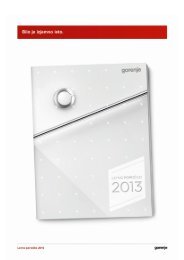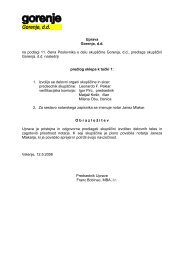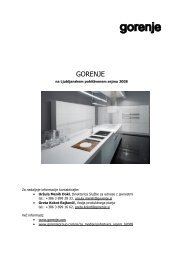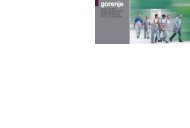Annual Report Gorenje Group 2009
Annual Report Gorenje Group 2009
Annual Report Gorenje Group 2009
You also want an ePaper? Increase the reach of your titles
YUMPU automatically turns print PDFs into web optimized ePapers that Google loves.
GROUP - 5. FINANCIAL RISK MANAGEMENT<br />
In respect of financial risk management, the internal financial policies comprising the bases for efficient<br />
and systematic risk management were observed in <strong>2009</strong>. The objectives of risk management are:<br />
• to achieve stability of operations and to reduce risk exposure to an acceptable level,<br />
• to increase the value of companies and the impact on their financial standing,<br />
• to increase financial income and/or to decrease financial expenses, and<br />
• to nullify and/or decrease the effects of exceptionally damaging events.<br />
In the <strong>Gorenje</strong> <strong>Group</strong>, the following key financial risks have been defined:<br />
Financial risk<br />
• Credit risk<br />
• Currency risk<br />
• Interest rate risk<br />
• Liquidity risk<br />
The exposure to each of the above risks and the hedge measures to be applied are judged and<br />
implemented on the basis of their effects on the cash flows. To hedge against financial risks in the<br />
course of ordinary business activities, relevant hedging activities have been conducted in the area of<br />
operating, investing and financing activities.<br />
In the light of the strained macroeconomic situation, more attention was paid in <strong>2009</strong> to the credit risk<br />
which includes all risks where the failure of a party (a buyer) to discharge contractual obligations<br />
results in a decrease in economic benefits of the <strong>Group</strong>. The credit risk was managed by application of<br />
the following sets of measures:<br />
• insurance of a major portion of operating receivables against credit risk with Slovenska<br />
izvozna družba - Prva kreditna zavarovalnica, d.d., and other insurance companies;<br />
• additional collateralisation of more risky trade receivables by bank guarantees and other<br />
security instruments;<br />
• regular monitoring of operation and financial standing of new and existing business partners,<br />
and limitation of exposure to certain business partners;<br />
• implementation of mutual and chain compensation with buyers;<br />
• systematic and active control of credit limits and collection of receivables.<br />
Taking into account the above mentioned hedge measures, the <strong>Gorenje</strong> <strong>Group</strong>'s management<br />
estimates that the exposure to credit risk has increased.<br />
With regard to the geographic diversification of its operations, the <strong>Gorenje</strong> <strong>Group</strong> is strongly exposed to<br />
currency risk, which is the risk that the economic benefits of an entity may be decreased due to<br />
changes in foreign exchange rates. When assessing the risks, balance sheet exposure has been<br />
considered. The currency risk mainly results from the performance of business activities in the markets<br />
of Serbia, Great Britain, Czech Republic, Slovakia, Poland, Hungary, Croatia, Turkey and the US dollar<br />
markets. A greater attention was paid to natural hedging of currency risks and harmonisation of<br />
business operations to ensure long-term decrease in currency fluctuation exposure by matching or<br />
netting sales and purchases. Additional short-term hedging is carried out by currency future contracts<br />
and short-term borrowings in local currencies. Irrespective of measures taken to hedge against<br />
currency risk, the <strong>Gorenje</strong> <strong>Group</strong>’s management estimates that, due to significant macroeconomic<br />
changes and oscillations in particular in the East European countries, the exposure to currency risk has<br />
increased.<br />
In the last few years, great attention was paid to interest rate risk, which is the risk that the economic<br />
benefits of the <strong>Group</strong> may be decreased due to changes in interest rates in the market. In <strong>2009</strong> the<br />
volume of hedging against interest rate risk was decreased over the previous year’s figure, so that the<br />
share of fixed interest rates and derivatives hedging against interest rate risk amounted to 47.5 percent<br />
115<br />
<strong>Annual</strong> <strong>Report</strong> <strong>Gorenje</strong> <strong>Group</strong> <strong>2009</strong>

















